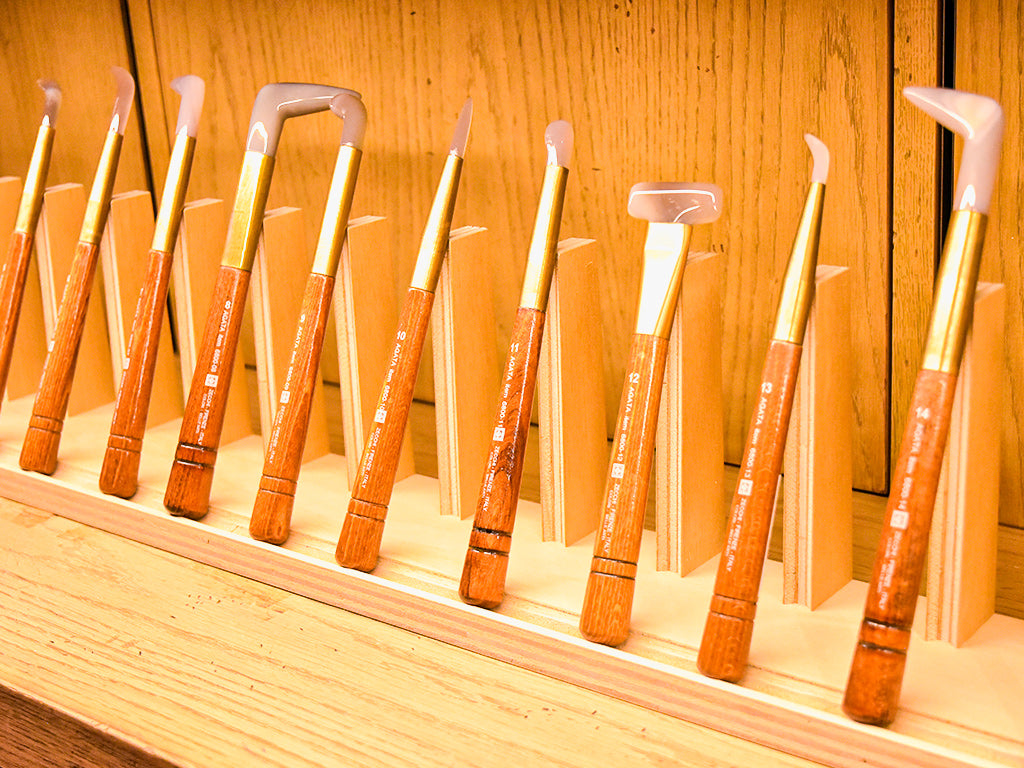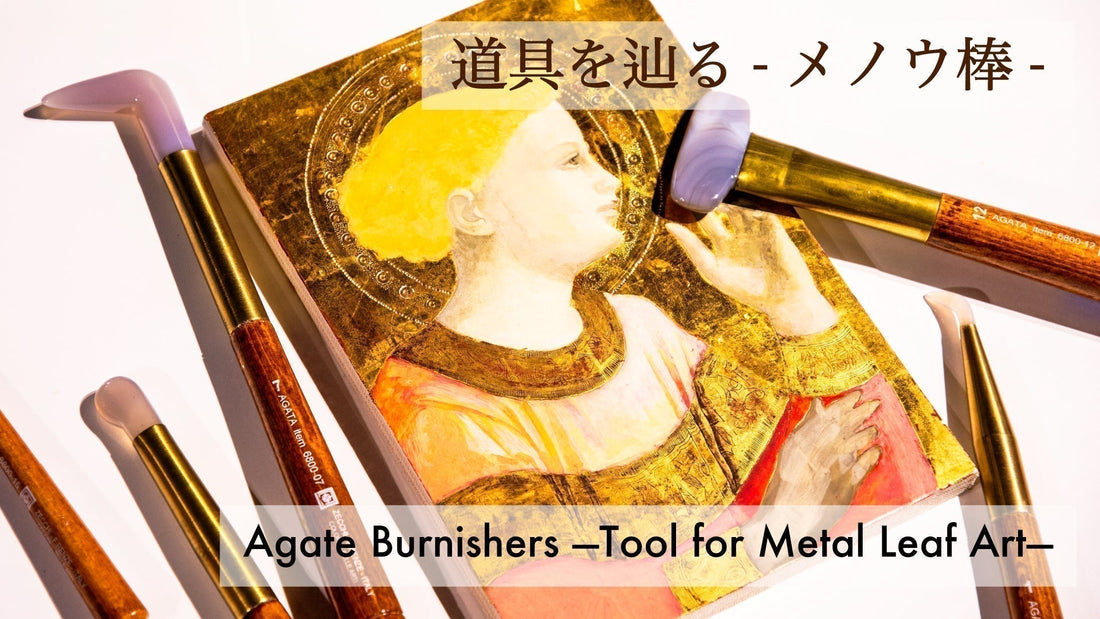Just as paintbrushes have different types of bristles that come with different designs and sizes to suit their purpose, so too do gilding tools vary according to their specific purpose, style and expression.
Artistic traditions have developed differently in Western countries and Japan, and the tools used to apply the metal leaf have evolved along with the culture, history, geography and environment of each country.
This time, I would like to introduce the "Agate Burnisher," which has a beautiful stone with a mysterious shape on top. This is also one of the art materials that are frequently asked about its use by visitors to PIGMENT TOKYO.

What is an Agate Burnisher?
As the name implies, Agate Burnishers are art materials with agate stones attached.
Have you ever seen the shiny, well-polished gold paintings and frames, also known as "gold ground" in classic religious paintings in the West? These agate burnishers have been used as a tool to polish these golden surfaces.
In the case of traditional paintings such as old Japanese folding screens and hanging scrolls, mineral pigments and metal leaf are applied to a substrate which is mainly Washi paper or silk. Since polishing is not necessary, agate burnishers have not been used in traditional Japanese art.
On the other hand, in medieval European paintings, tempera paint and gold leaf were applied to a chalk ground.
Therefore, a smooth surface stone such as agate was used to polish the gold leaf applied on the background of the painting to create a strong light or reflecting expression.
The following picture shows a tempera painting with a gold ground created by Natsumi Yamasato, who teaches workshops at PIGMENT TOKYO.

【Art Materials Used】
Substrate: Wooden board, Linen, Sottile Plaster (Gesso Sottile Di Volterra Gesso Doratori)
Basecoat: Gilder’s Clay (Assiette/Clay Bole) Red
Color: Tempera Paste
Medium: Egg Yolk
Metal Leaf: Italian Pure Gold Leaf 23.75K
*Gesso Sottile Di Volterra Gesso Doratori...Sorry, this item is no longer available.
If you are looking for a lustrous appearance of the gold leaf, the chalk ground is a good choice for the substrate. Moreover, the color of the base coat (clay bole), which comes out from the peeling part of the metal leaf, gives a great nuance to the color of the metal leaf.
Gold Polishing—Agate Burnishing Tool—
PIGMENT TOKYO carries all kinds of agate burnishes produced by ZECCHI, a long-established art supply store in Florence, Italy.
As mentioned above, although agate burnishers are used for polishing gold leaf that is applied on the background of a painting, they are mainly used for sculpted objects such as picture frames and church altars.
Many of you may have seen the gorgeous decorations in Italian churches or the heavy relief painting frames that are part of the classic Western paintings.

Benvenuto di Giovanni《Madonna and Child》1470, The Metropolitan Museum of Art
There are three main designs for agate burnishers.
◾️Curved Type ( No. 1, 2, 3, 4, 5, 6, 7, 8, 9, 11, 13, 14, 19, 20, 21 )
There are a variety of sizes and shapes, including curved and rounded ones. No. 9 and 11 have spherical rounded tips.
It is mainly used for curved or sculpted surfaces such as picture frames and reliefs, therefore, you could select the size and shape according to the form of the object.
◾️Flat Type ( No. 12, 16, 17, 18 )
Used for flat surfaces. A flat type agate burnisher is mainly used to polish metal leaf that is applied to flat surfaces.
No. 16 has the flattest and thinnest tip among them; the tips of No. 16, 17, and 18 are slightly curved; No. 18 is the largest and heaviest.
◾️Pointed Type ( No. 10, 15 )
These pointed type agate burnishers are sharper than the others, therefore, they are ideal for polishing detail work.
No. 10 is smaller and thinner, and No. 15 is slightly larger than No. 10.
Metal Leaf
When you’re polishing with an agate burnisher, it is better to use it on a thicker metal leaf.
Since the process of polishing gold leaf as if it were pressed is required for the Western-style gold ground paintings, the metal leaf that is made in Japan may be too thin for this gilding technique.
If you’re planning to polish the metal leaf in your work, Italian gold leaf like the ones below are highly recommended.
ZECCHI's pure gold leaf is known to be about three times thicker than Japanese gold leaf.
Regarding the size, while the Japanese pure gold leaf is about 10cm x 10cm, ZECCHI's Italian pure gold leaf is slightly smaller at 8cm x 8cm.
Moreover, the binding papers used to sandwich the metal leaves are bound in booklet form, which is completely different from those made in Japan.
Although it cannot be used in the technique of burnishing the metal leaf, the "Patent Transfer Gold - Book of 25 Leaves Double: Orange Gold" which is a booklet of Italian gold leaves made by ZECCHI is easily transferable since each gold leaf has already been applied on a piece of wax paper.
Other Gilding Tools and Materials
In addition to the agate burnishers, I’m going to introduce you to some other gilding tools that are slightly different from those commonly used in Japan.
◾️Italian Gilding Tools and Materials
In Italy, the metal leaf is cut with a knife, while in Japan, it is cut with a bamboo blade (竹刀, Chikutou). Because of the difference in blades, the gilding pads are also different: Italian gilding pads come with a cushion and shape like a small bump that is easy to cut with a knife, while Japanese gilding pads are mostly flat.
Moreover, in Italy, they also have Gilder's Tip, a type of gilding brush used for transferring sheets of metal leaf to another surface.
The way to use it is to apply a small amount of oil to the brush and gently transfer a piece of metal leaf with it. It comes in seven different sizes ranging from 20mm to 100mm wide.
You can select the size that best suits your creative needs.
Next, Gilding Size (Missione all'Acqua) is a water-based metal leaf adhesive made of acrylic resin. It can be stored at room temperature and is recommended for applying small detailed designs.
Click the link below if you’re interested in watching the actual process of using it on Instagram.
◾️【nstagram】ZECCHI's Restocked Items
◾️Sunago ( Japanese traditional technique )
The technique of burnishing metal leaves to create a sheen, as I introduced above, is difficult to apply to metal leaf pasted with the Japanese technique called Hiraoshi (平押し) which is to press the metal leaf flat. However, for fine metal leaf flakes or powders called Kindei (金泥) and Sunago (砂子) like the image below, it is possible to use agate burnishers to polish over them to achieve a gentle and soft shine that matches the Japanese aesthetic.

【Art Materials Used】
Substrate: Washi (Japanese Paper)
Metal Leaf: Kirimawashi (small pieces of metal leaf remains when it is cut into square)
Adhesive: Fish Glue, Alginate Liquid
This image shows the metal leaf flakes (Sunago) lightly rubbed and polished with an agate burnisher.
The slightly darker area at the lower right of the center of the image is the unpolished part. The other shiny areas have been polished.
In this image, the unpolished part looks much darker because of the way the metal leaf flakes reflect the light, but in reality, it is just a small difference in shine.
If the Western metal leaf is polished, it has a stronger luster like a gold nugget, while Japanese Sunago has a softer and misty glow.
However, please note that Sunago flakes can only be burnished after they have dried completely. Moreover, you need to be extra careful not to apply too much pressure, as it may cause scratches and peel on the paper and metal leaf.
Since various sizes and characteristics depend on the types of metal leaves, when you make a purchase, reading descriptions of each metal leaf is recommended.
From now on, when you see a gold leaf on a classical art piece, a frame, or an architectural structure, you have learned to enjoy it from a different perspective, thinking like "I could imagine using an agate burnisher polishing these golden backgrounds."
Recommended Agate Burnishers by PIGMENT Staff
Last but not the least, I asked Natsumi Yamasato who works at PIGMENT TOKYO but is also an artist using metal leaf and agate burnishers in her artworks, for the three most recommended agate burnishers.

Agate Burnishers No. 1, 12, 15
To start with, she said by having these three, you can work on curved surfaces, flat surfaces, and details. If you’re thinking of having your first agate burnisher but have no idea what to choose, perhaps these would be great options for you.
Workshops
Furthermore, although we won't be using agate burnishers, you can learn about traditional Japanese gilding tools and techniques in the following workshop.
If you are interested in learning more about traditional Japanese gilding materials and techniques, do not hesitate to join us! I’m sure it will be a great experience for you!

【Introduction to Metal Leaf】
Schedule: Once a month / Sunday
Time: 14:00 - 15:30
Location: PIGMENT TOKYO
Reservation: WORKSHOP—PIGMENT TOKYO
* Please note that the days and dates may change depending on circumstances.
For details, please check the schedule on the workshop reservation site.
Knowing and understanding art tools and materials broadens our perception of Eastern and Western culture and historical background, and makes us appreciate art even more.
Tools have created art and have been handed down by craftsmen, from masters to their students.
By finding out more about tools and using them for creating art in the contemporary world, we may be able to pass them down to new forms of artistic expression.
References:
・Golden Ground Tempera Painting Techniques -Mother of Oil Painting, Renaissance Plate Paintings Revived by Modern Hands (Arts Now -Series) Yasuo Taguchi (BIJUTSU SHUPPAN-SHA CO., LTD, 1978)
Translated by Atsumi Okano
PIGMENT TOKYO Art Materials Expert

















